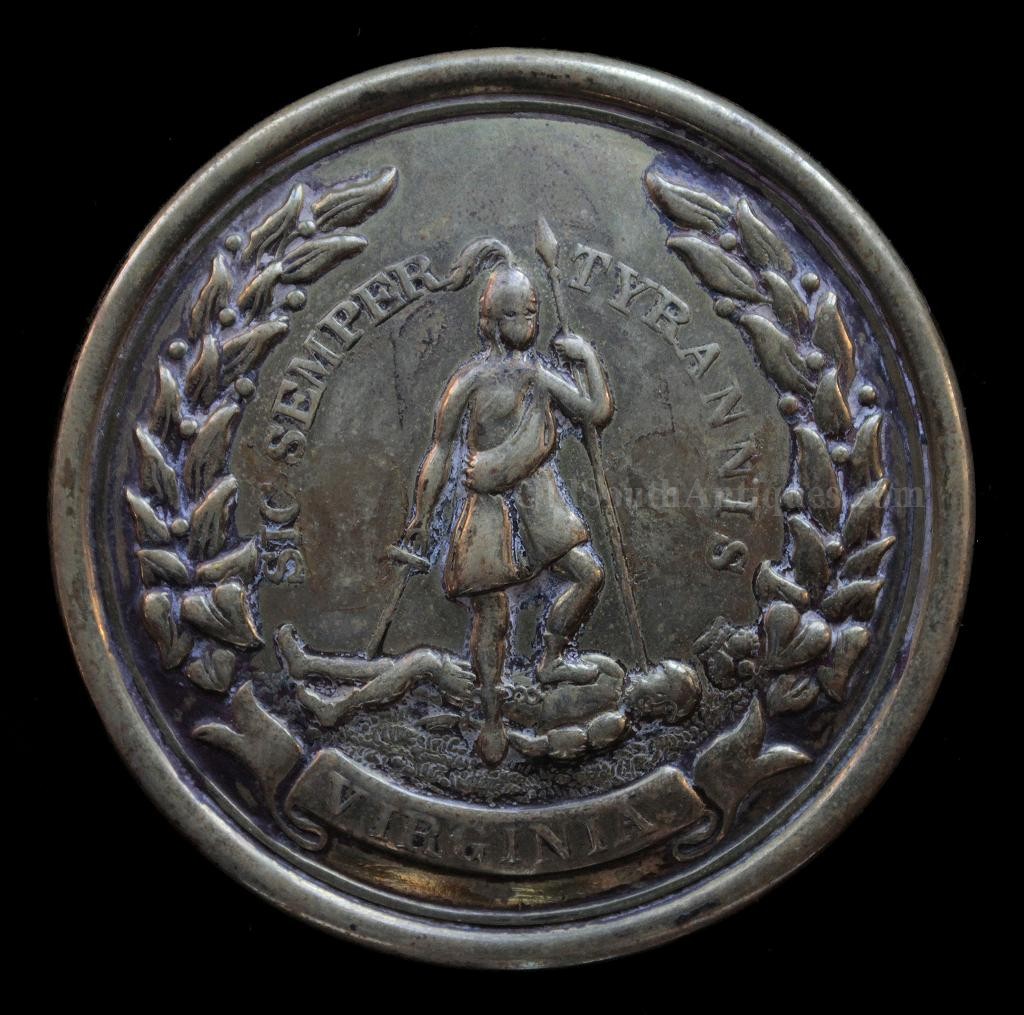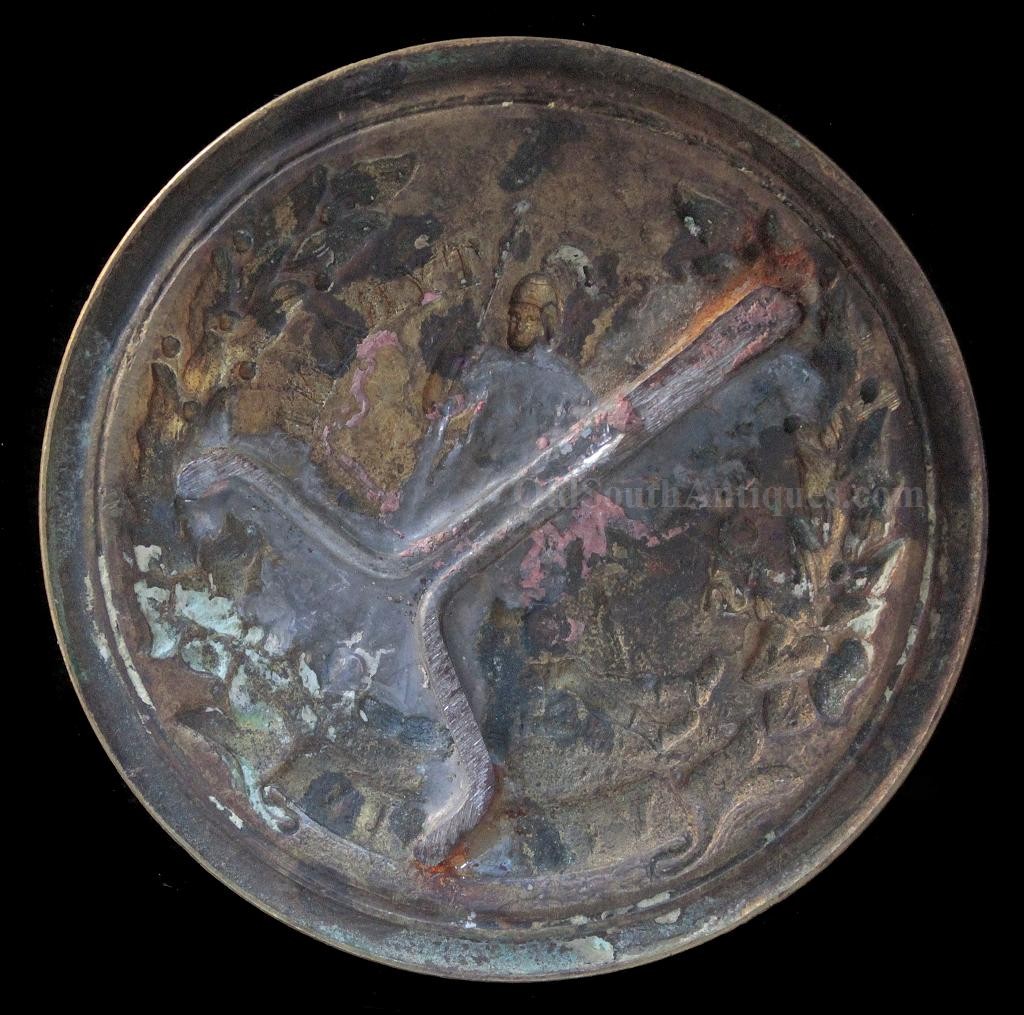
| Catalog | Past Items | Order Info | Terms/Conditions | About Us | Inventory Clearance |
In 1851, the Virginia legislature made an attempt at forming regiments of Volunteers but made little headway. The regiments were slow in forming because most Virginians saw no eminent threat and were reluctant to volunteer. By 1858, when Virginia’s governor reactivated the Virginia line, it was apparent that manpower needs were going to be greater than the Volunteer Militias could provide. In 1859, following John Brown’s infamous raid, Virginians began to seriously plan for defense; volunteer companies sprang up all over Virginia. When Lincoln illegally ordered Virginia to supply troops to invade and subjugate her sister states, Virginia withdrew from the Union and lifted her own flag. Men rushed to her standard from the farthest reaches of Virginia.
Though the earliest use of the Virginia coat of arms on plates dates to the 1830s, it was not widely used until it was prescribed for Virginia officers in 1858. Research done after Confederate Belt Buckles and Plates was published show this pattern to have been made by a W. H. Horstman die, either at the Virginia Armory, or at Horstman’s manufactory, prior to the War.
Three patterns of this State Seal exist, but any round Virginia plate is exceedingly rare. The few that are known seem to have originated with the Southern Guard, Company B, 11th Virginia Infantry. There were less than one hundred of all patterns made. The most common of the three is the enlisted man’s cross-belt plate. There are somewhere around twenty survivors in various conditions. The soldier who used these would have carried his bayonet scabbard on a white web belt slung over his shoulder and his musket cartridge box would have been carried on an identical belt slung over the other shoulder. These shoulder belts would have crossed at the breast and been locked in place by the breastplate with a stick pin, and then locked again at the waist by a web belt fastened with a plate bearing the Virginia seal.
There is one known round Virginia seal plate that has hook positions that demonstrate that it was used as a waist belt plate. In the Mullinax book it suggests that it was an early War conversion, but it may have been made in that configuration.
There are only two known round Non Commissioned Officer (NCO) Virginia Seal Plates. These served as an NCO sword belt plate. One of these was excavated in sight of Fairfax Court House Virginia, Circa 1998. The plate shown here is the only non-excavated example extant. It can be easily seen that this plate utilized a three hook wire frog that served as belt hooks. It can also be clearly seen that the clipped frog was set on an angle to buckle an over the shoulder belt for the NCO sword.
In the first months of 1860 men from Campbell County, Virginia organized the "Southern Guard” for local defense in response to the North’s support of the criminally insane John Brown. In May of 1861, the "Southern Guards” became Company B, Eleventh Virginia Infantry.
The Eleventh fought in nearly all the major engagements of the Army of Northern Virginia from Bull Run to Saylor’s Creek where they were virtually wiped out. Only one officer and twenty-eight men surrendered at Appomattox.
Confederate regulations called for ten NCOs per company in an ideal situation, but neither the early companies nor the late companies, or very likely the middle companies, ever had so many. Only the Southern Guards are known to have used them and judging from their rarity, it is very unlikely that anyone else ever did. These were only used by the NCOs and thus fewer than ten, and very likely only five, were ever manufactured. As such, this plate rates 10 on the Mullinax rarity scale.
Few Southern belt plates can be attributed to a specific maker and fewer still to a specific unit. This exceedingly rare die-struck, round Virginia State Seal NCO Sword Belt Plate is an exceptional exception.
Copyright © 2024 OldSouthAntiques.com All Rights Reserved.
Privacy Policy | Terms of Use
Powered by Web-Cat Copyright © 1996-2024 GrayCat Systems

